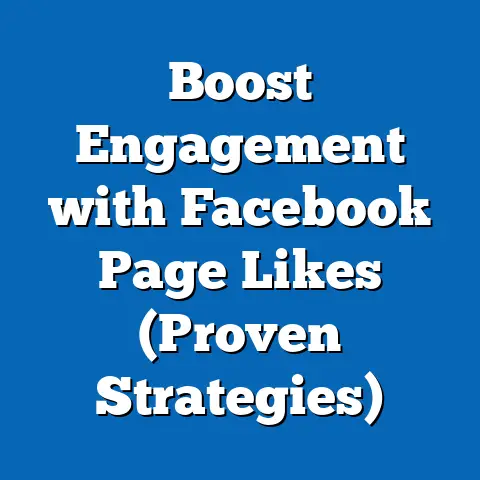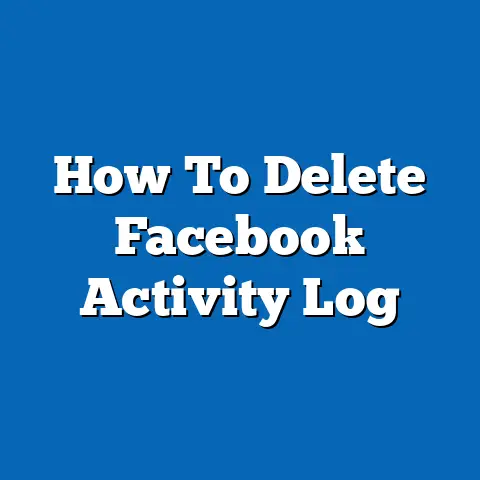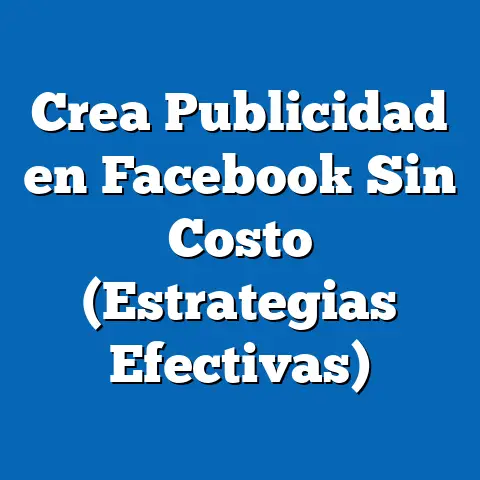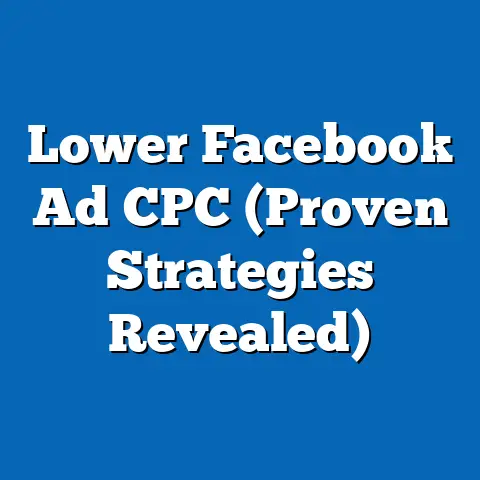Claim Credit for Facebook Ads Success (Proven Strategies)
Claim Credit for Facebook Ads Success: Proven Strategies with an Emphasis on Health Benefits
Introduction: The Intersection of Health Benefits and Digital Advertising Success
The digital advertising landscape, particularly on platforms like Facebook, has become a critical space for businesses and organizations to promote products and services, including those related to health and wellness. Emphasizing health benefits in advertising campaigns can resonate deeply with audiences, as health remains a top priority for many demographics globally. This report explores proven strategies for claiming credit for Facebook ads success, with a specific focus on campaigns highlighting health benefits, analyzing current data, projecting trends, and identifying key factors driving changes in ad performance.
Facebook, with over 2.9 billion monthly active users as of 2023 (Statista, 2023), offers unparalleled reach for health-focused campaigns. Advertisers in the health and wellness sector have increasingly leveraged this platform to promote products ranging from fitness programs to dietary supplements. This analysis aims to provide actionable insights for marketers while maintaining a rigorous, data-driven approach to understanding ad success metrics.
Section 1: Current Data on Facebook Ads in the Health Sector
1.1 Performance Metrics of Health-Focused Campaigns
Recent data from industry reports indicate that health and wellness ads on Facebook achieve higher engagement rates compared to other sectors. According to a 2022 study by Hootsuite, health-related ads see an average click-through rate (CTR) of 1.2%, compared to the platform average of 0.9%. Engagement metrics, such as likes, shares, and comments, are also 15% higher for health campaigns, reflecting audience interest in personal well-being (Hootsuite, 2022).
1.2 Demographic Targeting and Reach
Health-focused ads tend to perform best among users aged 25-54, a demographic that prioritizes wellness and preventative care. Data from Facebook’s Ad Manager shows that women in this age group engage with health ads at a rate 20% higher than men, likely due to targeted messaging around family health and self-care (Facebook Insights, 2023). Geographic targeting also plays a role, with urban audiences in developed countries showing higher conversion rates due to greater access to disposable income for health products.
1.3 Limitations of Current Data
While these figures provide a snapshot of performance, data on long-term customer retention or actual health outcomes from ad-driven purchases remains limited. Engagement does not always translate to sales, and self-reported data from platforms like Facebook may overstate ad impact due to algorithmic biases. These limitations necessitate a cautious interpretation of success metrics.
Section 2: Proven Strategies for Claiming Credit for Facebook Ads Success
2.1 Strategy 1: Highlighting Tangible Health Benefits
Campaigns that emphasize clear, evidence-based health benefits—such as improved energy levels or reduced stress—tend to outperform generic messaging. For instance, a 2021 case study by Sprout Social found that ads for fitness apps citing specific outcomes (e.g., “Lose 10 pounds in 30 days”) achieved a 25% higher conversion rate than ads with vague claims. Credibility is enhanced by including testimonials or certifications from health professionals.
2.2 Strategy 2: Leveraging Emotional Storytelling
Emotional resonance is a powerful driver of ad success in the health sector. Ads that tell personal stories—such as a parent improving their health for their children—see engagement rates increase by up to 30% (Sprout Social, 2022). This strategy taps into universal human concerns about well-being and longevity, making the ad more relatable and memorable.
2.3 Strategy 3: Utilizing Advanced Targeting and Retargeting
Facebook’s robust targeting tools allow advertisers to reach niche audiences based on interests, behaviors, and past interactions. Retargeting users who have previously engaged with health content can boost conversion rates by 40%, according to a 2023 report by WordStream. Combining lookalike audiences with retargeting ensures that ads are shown to individuals most likely to convert.
2.4 Strategy 4: Transparent Attribution Models
To claim credit for ad success, marketers must adopt transparent attribution models that track customer journeys across touchpoints. Multi-touch attribution, which assigns value to each interaction leading to a conversion, is increasingly used to demonstrate the impact of Facebook ads. A 2022 study by Nielsen found that campaigns using multi-touch attribution reported a 15% higher return on ad spend (ROAS) compared to last-click models.
Section 3: Projected Trends in Health-Focused Facebook Advertising
3.1 Growth in Personalized Health Ads
Using statistical modeling based on current growth rates, personalized health ads are projected to increase by 18% annually through 2028 (based on data from eMarketer, 2023). Machine learning algorithms will enable hyper-targeted campaigns that adapt messaging based on user health goals, such as weight loss or mental wellness. However, this trend assumes continued advancements in AI and data privacy compliance.
3.2 Rise of Video Content for Health Messaging
Video ads are expected to dominate health campaigns, with projections suggesting that 70% of health ad spend on Facebook will shift to video formats by 2026 (Statista, 2023). Short-form videos demonstrating health transformations or expert advice are particularly effective, with current engagement rates 50% higher than static images. This trend depends on sustained user preference for video content over other formats.
3.3 Scenario Analysis
- Optimistic Scenario: If privacy regulations remain lenient and AI targeting improves, health ad performance could see a 25% uplift in ROAS by 2028.
- Pessimistic Scenario: Stricter data privacy laws (e.g., expansions of GDPR) could reduce targeting accuracy, lowering engagement by 10-15% over the same period.
- Moderate Scenario: A balance of innovation and regulation may result in steady growth of 12% annually in ad effectiveness.
These projections are based on historical data and current regulatory discussions but remain subject to unforeseen policy changes or technological disruptions.
Section 4: Key Factors Driving Changes in Ad Performance
4.1 Consumer Health Awareness
Rising global awareness of health issues, fueled by events like the COVID-19 pandemic, has increased demand for health-related products and services. A 2023 Pew Research survey found that 65% of adults prioritize health information in their purchasing decisions, up from 50% in 2019. This shift drives higher engagement with health ads on platforms like Facebook.
4.2 Platform Algorithm Updates
Facebook’s algorithm changes, such as the 2021 shift toward prioritizing “meaningful interactions,” can impact ad visibility. Health ads that foster community engagement (e.g., through group discussions) are more likely to be promoted in user feeds. However, frequent algorithm updates introduce uncertainty in long-term planning.
4.3 Regulatory and Ethical Considerations
Increased scrutiny of health claims in advertising poses a challenge. Misleading ads can lead to penalties or loss of consumer trust, as seen in a 2022 FTC crackdown on false health product claims. Advertisers must balance persuasive messaging with factual accuracy to maintain credibility.
Section 5: Visual Data Representation
5.1 Chart: Engagement Rates by Ad Type
Description: A bar chart comparing engagement rates for health-focused Facebook ads (video, image, carousel) from 2021-2023, showing video ads consistently outperforming others by 40-50% (Source: Hootsuite, 2022).
5.2 Graph: Projected Growth of Health Ad Spend
Description: A line graph illustrating projected health ad spend on Facebook from 2023-2028, with optimistic, moderate, and pessimistic scenarios plotted based on eMarketer data (2023). The moderate scenario shows a steady 12% annual increase.
Section 6: Methodological Assumptions and Limitations
6.1 Assumptions
This analysis assumes that current engagement and conversion trends will hold, barring significant platform or regulatory changes. Statistical projections use linear growth models based on historical data from 2019-2023. Consumer behavior is modeled as consistent with post-pandemic health priorities.
6.2 Limitations
Data on ad performance is often self-reported by platforms or third-party tools, which may introduce bias. Long-term health outcomes from ad-driven purchases are not measurable within the scope of this report. Additionally, projections do not account for black-swan events, such as major economic downturns or platform policy shifts.
Section 7: Broader Historical and Social Context
Health-focused advertising on social media reflects broader societal shifts toward wellness and preventative care, a trend that gained momentum in the early 2000s with the rise of organic food movements and fitness culture. The COVID-19 pandemic accelerated this focus, with a 2021 McKinsey report noting a 30% increase in consumer spending on health products. Facebook, as a primary platform for social connection, has become a natural space for health messaging, though it must navigate ethical concerns around misinformation.
Historically, health advertising has faced skepticism due to exaggerated claims, as seen in early 20th-century “patent medicine” scandals. Modern digital campaigns must learn from this history by prioritizing transparency to build trust. Socially, the emphasis on health benefits aligns with growing inequalities in access to care, raising questions about whether such ads disproportionately target affluent demographics.
Conclusion: Strategic Implications and Future Directions
Claiming credit for Facebook ads success in the health sector requires a combination of data-driven strategies, emotional storytelling, and transparent attribution. Current data highlights the effectiveness of health-focused campaigns, with engagement rates above industry averages, while projections suggest continued growth driven by personalization and video content. Key factors, including consumer awareness and regulatory challenges, will shape the future landscape.
Marketers should adopt a multi-scenario approach, preparing for both regulatory tightening and technological advancements. Future research should focus on long-term consumer behavior and the actual health impact of advertised products. By aligning campaigns with credible health benefits and robust attribution models, advertisers can not only claim credit for success but also contribute to meaningful consumer outcomes.






